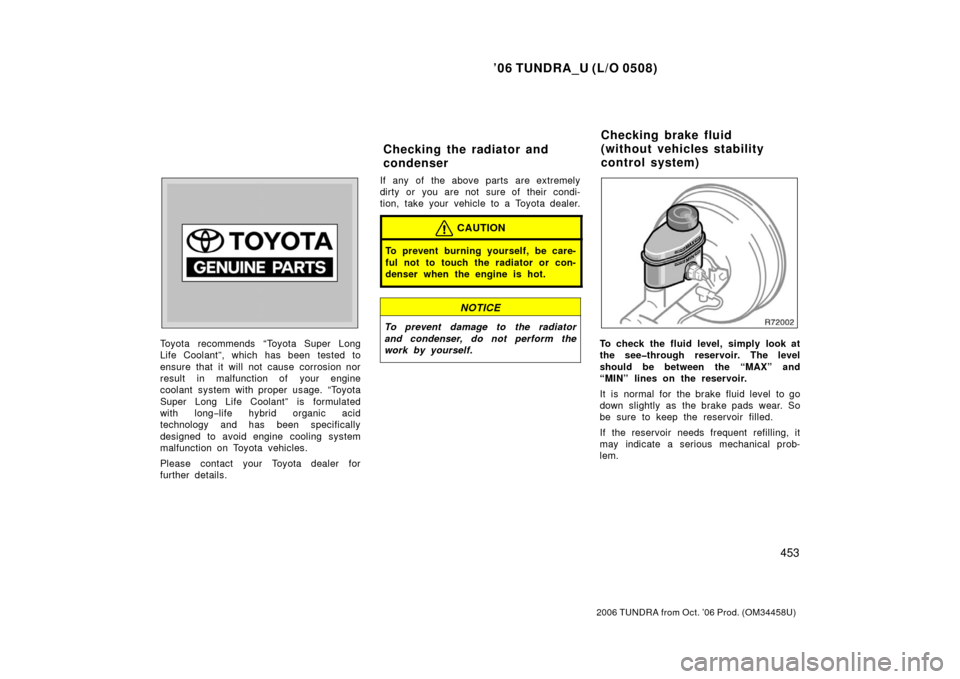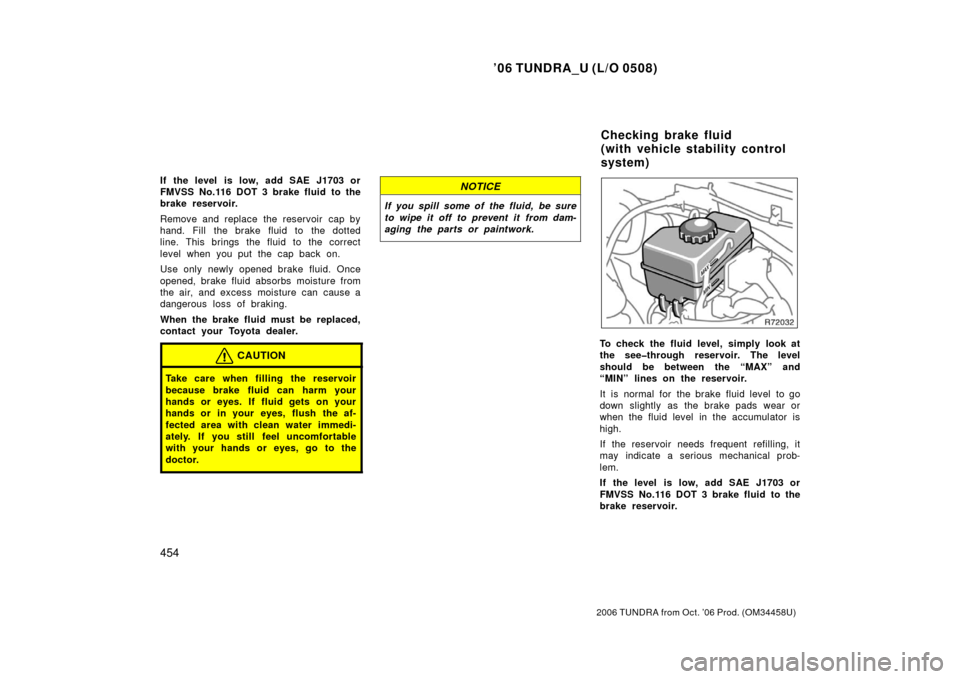Page 376 of 527

’06 TUNDRA_U (L/O 0508)
364
2006 TUNDRA from Oct. ’06 Prod. (OM 34458U)
BRAKE ASSIST SYSTEM (with the ve-
hicle stability control system)
When you slam the brakes on, the
brake assist system judges as an emer-
gency stop and provides more powerful
braking for a driver who cannot hold
down the brake pedal firmly.
When you slam the brakes on, more pow-
erful braking will be applied. At this time,
you may hear a sound in the engine
compartment and feel the vibrations of the
brake pedal. This does not indicate a mal-
function.
The brake assist system becomes opera-
tive after the vehicle has accelerated to
a speed in excess of approximately 10
km/h (6 mph). It stops operating when the
vehicle decelerates to a speed below
approximately 5 km/h (3 mph).
For an explanation of this system’s warn-
ing light, see “Service reminder indicators
and warning buzzers” in Section 1− 6.
The brake pad wear limit indicators on
your disc brakes give a warning noise
when the brake pads are worn to where
replacement is required.
If you hear a squealing or scraping noise
while driving, have the brake pads
checked and replaced by your Toyota
dealer as soon as possible. Expensive ro-
tor damage can result if the pads are not
replaced when necessary.The rear step bumper is for rear end
protection and easier step�up loading.
CAUTION
�Do not allow more than one person
to get on the rear step bumper at
a time. It is designed for only one
person.
�Never drive the vehicle with anyone
on the rear step bumper.
Brake pad wear limit
indicators Rear step bumper
Page 465 of 527

’06 TUNDRA_U (L/O 0508)
453
2006 TUNDRA from Oct. ’06 Prod. (OM 34458U)
Toyota recommends “Toyota Super Long
Life Coolant”, which has been tested to
ensure that it will not cause corrosion nor
result in malfunction of your engine
coolant system with proper usage. “Toyota
Super Long Life Coolant” is formulated
with long−life hybrid organic acid
technology and has been specifically
designed to avoid engine cooling system
malfunction on Toyota vehicles.
Please contact your Toyota dealer for
further details. If any of the above parts are extremely
dirty or you are not sure of their condi-
tion, take your vehicle to a Toyota dealer.
CAUTION
To prevent burning yourself, be care-
ful not to touch the radiator or con-
denser when the engine is hot.
NOTICE
To prevent damage to the radiator
and condenser, do not perform the
work by yourself.
To check the fluid level, simply look at
the see�through reservoir. The level
should be between the “MAX” and
“MIN” lines on the reservoir.
It is normal for the brake fluid level to go
down slightly as the brake pads wear. So
be sure to keep the reservoir filled.
If the reservoir needs frequent refi
lling, it
may indicate a serious mechanical prob-
lem.
Checking the radiator and
condenser Checking brake fluid
(without vehicl
es stability
control system)
Page 466 of 527

’06 TUNDRA_U (L/O 0508)
454
2006 TUNDRA from Oct. ’06 Prod. (OM 34458U)
If the level is low, add SAE J1703 or
FMVSS No.116 DOT 3 brake fluid to the
brake reservoir.
Remove and replace the reservoir cap by
hand. Fill the brake fluid to the dotted
line. This brings the fluid to the correct
level when you put the cap back on.
Use only newly opened brake fluid. Once
opened, brake fluid absorbs moisture from
the air, and excess moisture can cause a
dangerous loss of braking.
When the brake fluid must be replaced,
contact your Toyota dealer.
CAUTION
Take care when filling the r eservoir
because brake fluid can harm your
hands or eyes. If fluid gets on your
hands or in your eyes, flush the af-
fected area with clean water immedi-
ately. If you still feel uncomfortable
with your hands or eyes, go to the
doctor.
NOTICE
If you spill some of the fluid, be sure
to wipe it off to prevent it from dam-
aging the parts or paintwork.
To check the fluid level, simply look at
the see�through reservoir. The level
should be between the “MAX” and
“MIN” lines on the reservoir.
It is normal for the brake fluid level to go
down slightly as the brake pads wear or
when the fluid level in the accumulator is
high.
If the reservoir needs frequent refi lling, it
may indicate a serious mechanical prob-
lem.
If the level is low, add SAE J1703 or
FMVSS No.116 DOT 3 brake fluid to the
brake reservoir.
Checking brake fluid
(with vehicle stability control
system)